| |
 Morris Frank, Dorothy Harrison Eustis, and Buddy I, the founders of The Seeing Eye. (Photo: The Seeing Eye)
Seventy-five years ago this week a blind man named Morris Frank traveled from Tennessee to Switzerland to meet a dog. Not just any dog, but Buddy, a female German Shepherd who had been trained to be his guide. Mr. Frank received his dog from Dorothy Eustis, a canine trainer for police and rescue work. Ms. Eustis had become interested in guide dogs after visiting a school in Germany that had taught them to help blind war veterans. An article she wrote inspired Mr. Frank to imagine greater independence for blind people everywhere. He and Ms. Eustis agreed to pursue this goal together, starting with the training of Buddy. Morris Frank, Dorothy Harrison Eustis, and Buddy I, the founders of The Seeing Eye. (Photo: The Seeing Eye)
Seventy-five years ago this week a blind man named Morris Frank traveled from Tennessee to Switzerland to meet a dog. Not just any dog, but Buddy, a female German Shepherd who had been trained to be his guide. Mr. Frank received his dog from Dorothy Eustis, a canine trainer for police and rescue work. Ms. Eustis had become interested in guide dogs after visiting a school in Germany that had taught them to help blind war veterans. An article she wrote inspired Mr. Frank to imagine greater independence for blind people everywhere. He and Ms. Eustis agreed to pursue this goal together, starting with the training of Buddy.
When Morris Frank took Buddy home, she became the first official guide dog in America. The pair toured the nation together, attracting attention from the public and the press. People were amazed by their ability to navigate busy streets and master other challenges of daily life. Morris Frank was thrilled by his new freedom and Dorothy Eustis soon opened the first school in the United States for guide dogs for the blind, which she named The Seeing Eye.
There are about 7,000 guide dogs working in America today. They are trained to respond to commands but also to think on their own – to disobey if told to cross the street when a car is coming. Perhaps most difficult of all is learning to ignore other dogs and cats while on duty.
And for this week, that's the Living on Earth almanac.
[MUSIC]
Related link:
The Seeing Eye Back to top
CURWOOD: Ever since the landmark book “Silent Spring” by Rachel Carson, PCB's and dioxins have taken center stage in the debate over environmental toxins. There is less awareness of a similar class of chemicals called PBDEs, increasingly used to make flame retardants. Researchers recently found elevated levels of PBDE in mother's breast milk and fatty tissue in the San Francisco Bay area. To talk about the findings and possible health effects of PBDE, I am joined by lead author Myrto Petreas, environmental biochemist with California's Department of Toxic Substances Control. Also joining me is Tom McDonald, toxicologist for the California Environmental Protection Agency. Dr. Petreas, let's start with you. What exactly are PBDEs and where are they found?
PETREAS: PBDEs are flame retardants. There are three major industrial formulations of PBDEs and they're called the penta, the octa, and the deca. The penta is used in foam, used in furnishings, car seats. Very often the deca are used mostly with rigid plastics, like the computer monitor, the TV, other devices like that, so that it may prevent any flames or fires.
CURWOOD: Now you studied three groups of women in the San Francisco Bay area. Tell me about these three groups, and why did you choose to study these particular women?
PETREAS: The study you're referring to is combining data from three separate epidemiological studies that are still going on. We analyzed the tissues from these women’s blood or adipose – or fatty – tissue, for a number of chemicals, like the pesticides, PCBs, and PBDEs. And we found very high levels of PBDEs in two of the groups. And the most interesting thing was that the levels we found in these two groups were the highest we had ever seen, at least ten times higher than what was reported from Europe or Japan.
The other interesting thing is that we didn't find anything of these PBDEs in the third group of women. This was archived blood from the '60s, and we couldn't see the PBDEs. So what we could see in the '90s we could not see in the '60s.
In fact, what generated the interest in PBDEs was a few years back in Sweden, results from archived human milk from the '70s all the way to the '90s showed an exponential increase, so PBDEs were rising. And in the same sample of Swedish milk, all the other pesticides and dioxins and PCBs were dropping.
Now I should mention that the levels that generated all this interest in Sweden was less than ten times lower than what we are seeing here in California in the '90s.
CURWOOD: Tom McDonald, what do these PBDE levels suggest in terms of possible health effects, do you think?
MCDONALD: There's three primary concerns that we have with respect to health effects, and those include neuro-developmental changes, meaning learning and memory deficits in children, also thyroid hormone disruption, as well as possibly cancer. The concern basically comes from animal studies. We have, for example, three independent laboratories now, one in Sweden, one in Italy, and one here in the United States, that have all shown that either in rats and mice when you give PBDEs to them, either in utero or early after birth, you get permanent changes in behavior and learning and memory. And these are very similar to what we see with the PCBs, which is also a very similar chemical in both structure and activity.
CURWOOD: What do we know about how these chemicals might have gotten into human fat tissue and blood?
PETREAS: PBDEs are what we call persistent bioaccumulative chemicals. They get released into the environment, and because they are persistent, they don't break down. They get into the food web. So most of our exposure comes through the diet. Once they're in the body, because they don't metabolize so easily, they stay a long time and they store in the fatty tissues.
Now, the interesting thing about PBDEs is that, in addition to the diet, we think that we may be exposed to them through either inhalation or ingestion of dust. PBDEs have been measured in offices and homes and we think they may be coming from the use of consumer products, particularly foam, which may be friable, coming out through the fabric, maybe, of a sofa. And then we get exposed to them as well.
CURWOOD: What regulations exist for this type of flame retardant?
PETREAS: There are no regulations in the United States. Recently the European Union banned the use of penta and octa. The deca is still under investigation, waiting for a risk assessment to be completed.
CURWOOD: Now what are the advantages to using this class of chemicals as flame retardants?
MCDONALD: Indeed, it's very important that we do have products that don't burn quickly. California is one state that has very stringent fire safety flame retardancy standards, and I think a lot of the consumer products that are produced in the U.S. are made so that they meet California standards. For example, the PBDEs are added to plastics and foam, sometimes as much as 10 percent of the weight of the material. And when a plastic or a foam starts to burn, the PBDE actually quenches the fire and slows the burning and saves lives.
CURWOOD: How much does the U.S. consume of this stuff?
MCDONALD: Well, current estimates range on the order of somewhere about 75 million pounds per year, so this is quite a high-use chemical. These are such ubiquitous contaminants that I think we're all exposed to low levels of these.
CURWOOD: Tom McDonald is a toxicologist with the California Environmental Protection Agency. Myrto Petreas is an environmental biochemist with California's Department of Toxic Substances Control. Thank you both for speaking with me today.
PETREAS: Thank you.
MCDONALD: It was a pleasure.
Back to top
CURWOOD: When the federal government built dams and pipes to carry water from Northern California to the baking hot San Joaquin Valley, it was a high risk that intensive irrigation could eventually make the soil salty. Forty years later, some land is so contaminated with salt that it kills crops. The water and the agricultural riches it produced built a powerful farmer's lobby, the Westlands Water District. Farmers there say that if they stop farming the salty land, they should be compensated, and taxpayers could end up paying hundreds of millions of dollars. From member station KQED, Tamara Keith has more.
KEITH: Reliable irrigation water transformed the west side of the San Joaquin Valley, making the desert bloom with dozens of crops: almonds, cotton, tomatoes, garlic, and lettuce.
[SOUND OF MACHINERY]
KEITH: On a recent morning about 50 farm workers methodically moved through a field of romaine, plucking each head from the ground, removing the outside leaves and putting the hearts into boxes. This time of year almost all of the lettuce in the country is grown in the Westlands Water District. But the bounty comes at a cost. Over time the land is slowly being poisoned by natural salts in the water used to irrigate it. Now farmers like Paul Betancourt, are watching their land become less productive.
BETANCOURT: We grew four bails of cotton an acre in this field right here, and on the north 80-acre blocks we grew two bails of cotton this last year. That's how significant a difference it is.
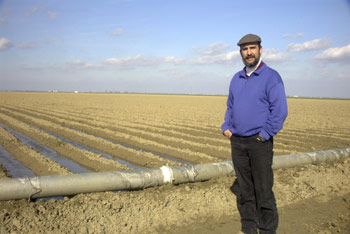

Farmer Paul Betancourt irrigating his cotton field.
(Photo: Tamara Keith)
KEITH: In some spots you can actually see white salt crystals form a crust on the soil.
[WATER SOUNDS]
KEITH: Irrigation water gushes out of a pipe into Betancourt's field. It will keep flowing like this for 48 hours, until he shuts the pipes off. Betancourt is hoping this land will see him through retirement, but he's worried.
BETANCOURT: This soil will eventually become worthless. And the farmers end up paying the price for that, because we've invested our lives in these farms with the hope of having drainage service so we could farm them in perpetuity. Which is a good idea, and that won't happen now.
KEITH: About two years ago Westlands Water District officials began pushing for a solution that few would have predicted: retire up to 200,000 acres of salt-contaminated cropland, cutting the farming here by a third. Although too salty for crops, farmers say the land can be restored, and could one day provide habitat for endangered species. Growers want that federal government to pay a fair market price for the land, and the bill could come to half a billion dollars or more. Thad Betner is the deputy general manager of resources for the Westlands Water District.
BETNER: They have the highest crop yields out of anywhere else in the valley. They can grow a variety of different crops that can't be grown anywhere else. And to take this land out of production, it's unfortunate, but that's the reality we have to live with.
KEITH: When the federal government first built the dams and piped in the water, officials knew they'd need to carry away the salty wastewater. The original plan was to send the water into the San Francisco Bay Delta, but because of fears that the Delta would be harmed by the water, the drain was never finished. Instead, the brackish water was dumped into the Kesterson Wildlife Refuge in Merced County. Then, 20 years ago, Kesterson became synonymous with environmental disaster.
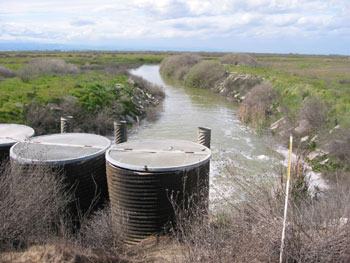

The end of the San Luis drain, which once carried Westlands
irrigation water to the Kesterson Wildlife Refuge.
(Photo: Lloyd Carter)
[NATURAL SOUNDS]
KEITH: At the time, environmentalist Lloyd Carter was a reporter for United Press International. He was one of the first to cover the story of selenium poisoning at Kesterson from the Westlands drain water.
CARTER: And when I got out of my car, the first thing that overwhelmed me was this sulfurous smell. And then I looked around out onto this pond here to the northwest and I saw hundreds, if not thousands, of dead birds floating amongst the living birds.
KEITH: Now an environmentalist with the group California Save our Streams, Carter says it was like a scene straight out of the Alfred Hitchcock movie The Birds.
CARTER: The marsh is actually a quite noisy place. It's full of life and birds. And Kesterson was strangely silent. It was quiet, because everything was dying.
KEITH: The pools of toxic water were eventually dried out and covered over with dirt to protect the birds. Westlands' drain water was shut off. Today the federal government is still working to provide drainage to the western San Joaquin Valley under a court order, and one possibility would be new evaporation ponds. Environmentalists are skeptical. But officials say they've learned from Kesterson, and any new ponds wouldn't harm wildlife. Jason Phillips with the U.S. Bureau of Reclamation is studying the options.
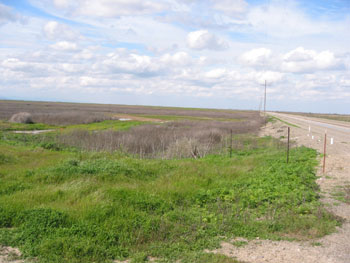

The Kesterson Wildlife Refuge today
with the ponds filled in with dirt.
(Photo: Lloyd Carter)
PHILLIPS: Really, there's only three places you can take it. You can take it directly to the Pacific Ocean, you can take it to the Bay Delta, which is the original envisioned disposal location, or keep it within the valley and evaporate it.
KEITH: But each of these options could cost as much as a billion dollars and may create other environmental problems. Meanwhile, a handful of farmers are already getting money to idle their fields. They had sued the government, saying the lack of drainage destroyed their land. Under a settlement reached earlier this year, the farmers will get 100 million dollars in damages and 40 million to retire their land. Like the officials at Westlands, environmentalist Lloyd Carter is pushing for a massive land retirement, though he isn't at all happy about the idea of the government paying for it.
CARTER: This is all to benefit 600 growers. History will show that this was one of the great, stupid mistakes of the federal government in pouring literally billions of dollars into a project on lands which should have never been farmed.
KEITH: If the federal government agrees to buy out all the salt-contaminated land, it would be a first. Already farmers in other parts of the state dealing with water supply problems are beginning to call for land retirement programs of their own. Any deal with Westlands would be precedent-setting, so many eyes are watching. Environmentalists look at land retirement as a chance to return water to the rivers it was diverted from decades ago. But Westlands officials want to keep the water for their remaining acreage. For Living on Earth, I'm Tamara Keith in Fresno County.
CURWOOD: You're listening to NPR's Living on Earth.
ANNOUNCER: Funding for Living on Earth comes from the World Media Foundation. Major contributors include the Ford Foundation, for reporting on U.S. environment and development issues, and the William and Flora Hewlett Foundation, for coverage of western issues. Support also comes from NPR member stations and the Noyce Foundation, dedicated to improving math and science instruction from kindergarten through grade 12, and Bob Williams and Meg Caldwell, honoring NPR's coverage of environmental and natural resource issues, and in support of the NPR President's Council.
Related links:
- Westlands Water District
- San Luis National Wildlife Refuge Back to top
CURWOOD: Many New Yorkers are resigned to the fact that parks and pigeons are an eternal partnership. But Bryant Park in midtown Manhattan is trying out a novel plan to get rid of the winged loiterers and their droppings. Park administrators have called in a team of hawks to scare off the pigeons. Tom Cullen is the raptor specialist who is running the program. Tom, how do you and the hawks on your crew go about getting rid of the pigeons in the park?
CULLEN: Basically the Harris’ hawk is a bird that's specifically designed to catch ground quarry, things like rodents and squirrels, rabbits. The pigeons don't realize that the particular hawk that I'm using is not well adapted to catch them, and what we're relying on is the instinctive behavior of pigeons to avoid hawks. We're not actually hunting the pigeons, per se, in the park. What we're doing is we're using that natural fear to build the stress level up, so that the pigeons basically avoid the area because there's a predator on the prowl.
CURWOOD: How do you control your hawks?
CULLEN: Basically, we use the ancient methods of falconry to train the birds. Basically, they're taught to come to us for food. And so we control them that way. My birds are trained to follow me like a dog would, except, of course, they follow me from treetop to treetop.
CURWOOD: So what sort of controls do you use, your body, your voice? How do you do this?
CULLEN: A little bit of both. I can get their attention by yelling at them or whistling to them so that they turn their head. But because they're so visually orientated, what I have to do to actually bring them down is show them something, either a lure that's dragged along the ground or actually just a small piece of meat, and place it in my gloved hand and they come down to that.
CURWOOD: Maybe you could let us hear what it sounds like when you call one of your hawks back to you.
CULLEN: Oh just kind of a [WHISTLES] and you can hear her bells in the background here. She wears bells so that I can locate her if she were to go down into cover. So I kind of hear a jingle-jingle as she follows me along.
CURWOOD: What's her name?
CULLEN: The one I have on my fist at the moment is called Starbuck.
CURWOOD: So she does caffeine in the morning, I take it.
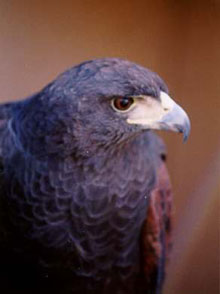 Harris’ Hawk (Photo: Southwest Wildlife) Harris’ Hawk (Photo: Southwest Wildlife) |
CULLEN: Well, they're kind of a dark, chocolatey-brown bird with a little bit of, kind of, reddish shoulders. And I named one of them Mocha, so then I ended up naming another Java. So Starbuck just kind of seemed to fall in line.
CURWOOD: You're a man who enjoys a good cup of coffee.
CULLEN: That's right.
CURWOOD: You know, if these pigeons get moved out of Bryant Park, then may be they get moved out of Times Square, and maybe they get moved out of…
CULLEN: Well they can always go to Jersey. That would suit me. [laughter] As long as they're out of Bryant Park, I'm happy. Again, if I leave, it's more than likely they're going to come back in again. So it is a kind of maintenance program that we're doing here.
CURWOOD: Tom Cullen is a raptor specialist. He talked to us from Bryant Park in New York. Hey, are you going to fly your birds now?
CULLEN: Yes. [BELLS RINGING]
CURWOOD: Thanks a lot, Tom.
CULLEN: Okay.
Related link:
Bryant Park Information Pages Back to top
CURWOOD: Coming up, oil and war in the tropical heat of Colombia. First, this note on emerging science from Maggie Villiger.
[MUSIC: Science Note Theme]
VILLIGER: Everyone knows it's important to protect your skin from the sun. Now scientists from the United States Department of Agriculture have developed an all-natural way to ward off those damaging rays. Researchers were examining the chemical structure of ferulic acid, an antioxidant that's found in the cell walls of oat and rice bran. They noticed that ferulic acid's structure is remarkably similar to the UV-absorbing chemicals currently used in sunscreens, and they discovered it in fact shared their sun-protective properties. But on its own, ferulic acid would be an impractical sunscreen, since it's soluble in water, and no one wants a sunscreen that easily washes or sweats off.
So the scientists figured out how to combine soybean oil and ferulic acid to form a molecule that absorbs UV rays and doesn't dissolve in water. They dubbed it SoyScreen. The product's manufacturing process is environmentally benign, since it relies on a low-temperature reaction helped along by an enzyme that can be recycled repeatedly.
Another advantage: SoyScreen breaks down in the environment and doesn't bio-accumulate like other chemicals currently used as sunscreens. The company licensing SoyScreen hopes to test-market cosmetic products containing the new ingredient by the end of the year. That's this week's note on emerging science. I'm Maggie Villiger.
CURWOOD: And you're listening to Living on Earth.
[MUSIC: Gary Stroutsos “I am Walking” Winds of Honor - Makoche (1996)]
CURWOOD: Welcome back to Living On Earth, I'm Steve Curwood.
[MUSIC: West African Balafon Ensemble “Farfina” The Pulse of Life - Ellipsis (1992)]
CURWOOD: "Out on the Safari," writes Isak Dinesen in Out of Africa, "I had seen a herd of buffalo, 129 of them, come out of the morning midst, under a copper sky, one by one, as if the dark and massive iron-like animals with the mighty horizontally swung horns were not approaching, but were being created before my eyes, and sent out as they were finished. I had, time after time, watched the progression across the plain of the giraffe, in their queer, inimitable vegetative gracefulness, as if it were not a herd of animals, but a family of rare, long-stemmed, speckled, gigantic flowers slowing advancing.
I had followed two rhinos on their morning promenade, when they were sniffing and snorting in the air of the dawn, which is so cold that it hurts in the nose, and looked like two very big angular stones rollicking in the long valley and enjoying life together."
Thanks to Heritage Africa, you too can experience the wild as Dinesen did. Living On Earth is giving away a 15-day day trip for two on the ultimate African Safari, with visits to several of Africa's most spectacular game preserves, such as Kruger and the Serengeti. For more details about how to win this 15-day African Safari, just go to our website, loe.org. That's www.loe.org, for the trip of a lifetime.
[MUSIC: Carlos Guedes “Harposauras” A World Instrumental Collection - Putumayo (1996)]
Related link:
National Center for Agricultural Utilization Research site on SoyScreen
Back to top
CURWOOD: For almost four decades, Colombia has been wracked by a civil war that's killed tens of thousands of people, and also ravaged the environment. Colombia is a major oil-producing country, with much of that oil going to the United States. But in the last 20 years, millions of barrels of Colombia's oil have ended up in the soil and water. Rebels have been blowing up pipelines that carry oil for foreign companies, most often one jointly operated by the Colombian government and U.S.-based Occidental Petroleum. This pipeline transports 100,000 barrels of oil a day – that is, when it's up and running. Last year alone, attacks shut it down more than two-thirds of the time. A few months ago, the Bush administration ordered special forces into Colombia to train local soldiers to defend the pipeline. In the first of a two-part series on Colombia’s civil war and the environment, reporter Angela Swafford traveled to her homeland, and has this report.
SWAFFORD: This is the National Control Center of Ecopetrol, Colombia’s state oil company, located on the penthouse of a massive downtown building in Bogota. The place is a fortress, protected with thick security windows and doors. Like NASA mission control engineers, a dozen employees face computer screens intently monitoring every inch of its 7,500 miles of oil and gas pipelines that run throughout the country.
[SOUND OF AN ALARM]
An alarm here means the system has detected a sudden drop in oil pressure. Engineer John Garcia, points to a blinking red light on his computer screen.
GARCIA: [VOICEOVER] You can see here with the pipe is leaking, between kilometers 81 and 83. So let's inform people over at headquarters so they can start acting on this one.
[SPANISH]
SWAFFORD: Though it can't be verified yet, chances are this leak is actually the result of an attack, one of the many carried out each week by the country's two main leftist rebel groups. The Caño Limon-Coveñas pipeline has been attacked about 900 times in its 16-year history, spilling almost three million barrels of oil. In the common scale used to rate oil disasters, that amounts to 14 Exxon Valdezes. Again, engineer John Garcia.
GARCIA: [VOICEOVER] Each pipeline is equipped with remotely controlled check valves that close off the broken section of pipe. The trouble is that Colombia's geography is very complicated, and the first thing that get polluted are streams and rivers. But if we didn't have these valves, the environmental damage would be a lot worse.
SWAFFORD: Nevertheless, the damage that is done both to the environment and to human lives is dramatic. Those are the words of Colombia's former Minister of the Environment, Juan Mayr.
MAYR: [VOICEOVER] I had the opportunity of personally visiting a region where the guerillas had attacked a pipeline. It was the town of Machuca. The attack on the pipeline resulted in the death by burns of 80 Colombian citizens. And, of course, that is another tragedy, another drama of terrorism on our national oil infrastructure. This is why I think the topic of peace has a lot to do with the environment. I see in the future a day when we will be at peace, and Colombia will preserve its rich biodiversity. At the moment, what we have are hard times, times of environmental destruction.
SWAFFORD: A helicopter prepares to travel northeast from Bogota, towards the Venezuelan border, straight into territory held by the rebel armies known as the FARC and the ELN. On board is an Ecopetrol biologist.
RUEDA: [VOICEOVER] My name is Alvaro Rueda. I work for Ecopetrol, and we are heading to Banadía Pumping Station, along the Caño Limon-Coveñas pipeline, in order to see the areas affected by the oil spills resulting from recent terrorist attacks.
SWAFFORD: We take off in a light rain. The helicopter will eventually climb to 3,000 feet, high enough, I'm told, to avoid enemy bullets.
RUEDA: [VOICEOVER] As soon as we get notice of an oil spill, we fly over it to determine its location relative to the rivers in order to forecast where the oil will possibly travel. Then we rush back and formulate a contingency plan.
SWAFFORD: After 40 minutes, we begin to pass over undulating mountain ranges, covered by thick forests and dramatic jagged peaks. This is an area of Colombia rich in biodiversity. Somewhere down there the pipeline lies buried a few feet underneath the soil, a failed attempt to hide it from terrorists. Spills here have been especially difficult to clean up, since there is no easy access into this wilderness, and the rivers are quick to carry the oil downstream. But geography is not the only obstacle here. Just a couple of days ago the guerilla groups announced a step-up in violence, declaring that they would attack both military and civilian choppers attempting to land along the pipeline to carry out repairs. As the mountains turn into valleys, and the clouds part, I spot a large oil spill, a black insult against the green grass.
RUEDA: [VOICEOVER] Right now we are flying over a spill that is about 1,000 by 16,000 feet wide. We have still not been able to land down there because of security reasons. It is a dark spill, very recent. These are areas for yucca and maize crops.
SWAFFORD: Multiple attacks have occurred so close together here, their spills have merged into one long chain. To compound the devastation, the underground natural aquifer in this region lies very near the surface, so oil can easily penetrate it. Already, the spill has reached a field of food crops, and it's heading towards a wide, milky river some 10 miles west, where a small village lies on its bank. The Colombian government estimates that at least 10,000 farmers and fisherman have been affected in the past decade by the pipeline attacks, either through loss of crops, contamination of drinking water and soils, or pollution of fisheries.
SWAFFORD (in helicopter): We’re circling the station now. As we approach the station, we have to circle it so that we give less opportunity for the guerillas to shoot us down. This is one evasive measure.
Banadía Pumping Station is a dangerous place to live and work. Less than a mile from the pipeline, it has become a field operation center in the middle of the wilderness. From here, repair teams are dispatched to damaged portions of the pipeline. The first thing you see when you get off the chopper is a huge section of twisted, blown up pipe. In another time and place, it could look like a modern art sculpture, but here it silently announces what this place is about. 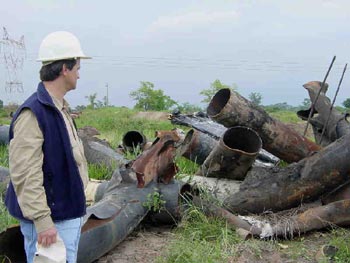

Crews are sent out on an almost weekly basis
to survey pipeline damage and make repairs.
Company employees move in to greet us. Several of them wear bulletproof vests. Five small, white buildings serve as housing and dining facilities here. Most have bunkers inside them, lined with sacks of sand. Employees are instructed to dive into them during a guerilla attack. Carlos Baguett is in charge of maintenance and repair here, and he has a lot to say about the perils of trying to do his job. He remembers being flown by helicopter a few months ago to a section of the pipeline that had been severely mauled by dynamite, the standard method of attack.
BAGUETT: [VOICEOVER] Yes, it was about 5 p.m. when we got there. We were getting the place organized to work where the pipeline had been broken. Then they started to launch cylinders stuffed with dynamite against the army, and we were right in between the army and the guerrillas. But, fortunately, nothing happened to us civilians. We had been instructed to lie on the ground, facing down, and to keep our mouths open so that the explosive wave would not rip us apart.
SWAFFORD: Not exactly a typical day at the office. Guerillas also plant mines next to the pipelines, so before workers can start repairs, the army must first clear the site, a process that can take days. We pass by destroyed sections of pipeline that now look like huge over-cooked pieces of pasta twisted and bent in a variety of shapes.
BAGUETT: [VOICEOVER] This is a cemetery of the blown up pieces of pipeline. Look, that is because of the impact of dynamite. Look at that other one, it is even pretty. Who knows how many kilos of explosives they use to leave it like that. They always place the dynamite underneath.
SWAFFORD: We enter one of several warehouses filled with equipment used to scoop up oil and repair pipeline.
BAGUETT: [VOICEOVER] Here we have a piece of equipment that is basically a power unit with rolls that you place on the surface of the river or lake. It has these hydraulic hoses that make the rolls spin and pick up the oil, which is then sent to a portable tank.
SWAFFORD: Baguett also uses suctioning equipment to soak oil from the ground.
BAGUETT: [VOICEOVER] Then we treat the soil with lime and slowly keep working on it until it is ready to be planted again. But when the spill takes place during the rainy season, the oil in the ground tends to resurface somewhere else, carried by the water in the aquifer, affecting places that were not contaminated before.
SWAFFORD: We walk away from the pumping station towards the pipeline. Since the tubes are buried, all I see is a slight change in the color of the grass. The part of the pipeline we're standing on now was attacked last year. The soil is light brown here, and the grass is dead. Ecopetrol biologist Alvaro Rueda.
RUEDA: [VOICEOVER] When I kick the soil, you can see how loose it is. The oil that was spilled last year here is underneath, in this very permeable soil. The deposit is still down there.
SWAFFORD: He digs through the sandy topsoil, and almost immediately the dirt turns darker brown. As I kneel down to take a look, I begin to smell oil. There is a small stream about 80 feet from us, and its banks are also stained in brown. Alvaro Rueda remembers the devastation as it happened.
RUEDA: [VOICEOVER] Though this is flat terrain, it does have some gradient. So the oil ended up in a stream that feeds a major river called Arauca. We managed to stop the large patch, but we lost many birds, like that kingfisher that you see over there. The oil makes sort of a mirror that confuses birds who mistake it for water. Saving them once they have fallen in oil is extremely difficult. Other species that always die are reptiles, like snakes, insects and amphibians. The vegetation along the river margins ends up totally covered in oil.
SWAFFORD: Ecopetrol estimates that over the years it has tried to clean up more than 12,000 miles of rivers and 3,700 acres of land throughout the country. But it's impossible to know the full extent of the damage suffered by the plant and animal life here, because the region is so dangerous. No in-depth scientific studies have been done on that question. Of course, if there were no pipeline attacks, the oil development here would still be controversial. It brings with it its own list of consequences, including air and water pollution, soil erosion, and disturbance of wildlife. But to see devastation that has been so purposely inflicted is particularly disturbing.
I look to the east toward Venezuela and to the mountains there that are surrounded in mist. Two helicopters appear in the distance, like silent dragonflies. They might be carrying the elite U.S. military personnel sent here to help protect these pipelines. Underneath those choppers lies an ecosystem under attack. This is the other often overlooked consequence of the Colombian civil war, an environment whose future depends on a peace that remains tragically elusive. In the Colombian state of Arauca, along the Caño Limon-Coveñas pipeline, I am Angela Swafford, for Living On Earth.
Related link:
Living on Earth Special Feature - Colombia Pipeline"> Back to top
CURWOOD: And for this week, that's Living On Earth. Next week, the second part of our series with Angela Swafford. Guerilla groups in Colombia make their money through the drug trade. The growing and processing of coca takes place in the country's most biodiverse region, its Amazonian forest.
MALE: In this region of the country, there are over 185,000 acres of coca crops planted right now. It is estimated that in order to maintain each planted acre, four more acres of forest need to be cleared. So the deforestation is, in fact, four times more serious.
CURWOOD: Narco crops and Colombia's environment, next time on Living On Earth. And right now, for more on this story, including photos and a reporter's notebook, go to our website at loe.org. That's loe.org where you can get the story behind the news.
[SOUNDS OF INSECTS: Earth Ear “Village/Cricket” Dreams of Gaia Earth Ear Records (1999)]
CURWOOD: We leave you this week taking a stroll on an African evening. David Dunn recorded these sounds on the outskirts of a Zimbabwe village.
[SOUNDS OF INSECTS]
CURWOOD: Living on Earth is produced by The World Media Foundation in cooperation with Harvard University. You can find us at www.loe.org. Our staff includes Anna Solomon-Greenbaum, Cynthia Graber, Maggie Villiger, and Jennifer Chu, along with Tom Simon, Jessica Penney, Al Avery, Susan Shepherd, Carly Ferguson, and Liz Lempert.
Special thanks to Ernie Silver. We had help this week from Katherine Lemcke, Jenny Cutrero and Nathan Marcy. Allison Dean composed our themes. Environmental sound art courtesy of EarthEar.
Our technical director is Chris Engles. Ingrid Lobet heads our western bureau. Diane Toomey is our science editor, Chris Ballman is the senior producer of Living on Earth, and senior editor Eileen Bolinsky produced this week's program.
I’m Steve Curwood, executive producer. Thanks for listening.
ANNOUNCER: Funding for Living on Earth comes from the World Media Foundation. Major contributors include: The National Science Foundation, supporting coverage of emerging science; and the Corporation for Public Broadcasting, supporting the Living on Earth Network, Living on Earth's expanded internet service. Support also comes from NPR member stations, and the Annenberg Foundation. And Tom’s of Maine, maker of natural care products and creator of the Rivers Awareness Program to preserve the nation’s waterways. Information at participating stores or tomsofmaine.com.
This Week's Music
Living on Earth wants to hear from you!
Living on Earth
62 Calef Highway, Suite 212
Lee, NH 03861
Telephone: 617-287-4121
E-mail: comments@loe.org
Donate to Living on Earth!
Living on Earth is an independent media program and relies entirely on contributions from listeners and institutions supporting public service. Please donate now to preserve an independent environmental voice.
NewsletterLiving on Earth offers a weekly delivery of the show's rundown to your mailbox. Sign up for our newsletter today!
 Sailors For The Sea: Be the change you want to sea. Sailors For The Sea: Be the change you want to sea.
 The Grantham Foundation for the Protection of the Environment: Committed to protecting and improving the health of the global environment. The Grantham Foundation for the Protection of the Environment: Committed to protecting and improving the health of the global environment.
 Contribute to Living on Earth and receive, as our gift to you, an archival print of one of Mark Seth Lender's extraordinary wildlife photographs. Follow the link to see Mark's current collection of photographs. Contribute to Living on Earth and receive, as our gift to you, an archival print of one of Mark Seth Lender's extraordinary wildlife photographs. Follow the link to see Mark's current collection of photographs.
 Buy a signed copy of Mark Seth Lender's book Smeagull the Seagull & support Living on Earth Buy a signed copy of Mark Seth Lender's book Smeagull the Seagull & support Living on Earth
| |

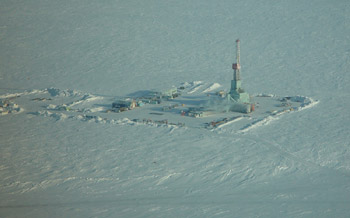
 Mote next to a quarter. (Photo: Intel)
Mote next to a quarter. (Photo: Intel) 
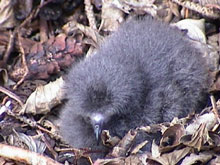 A young petrel. (Photo: John Anderson / College of the Atlantic)
A young petrel. (Photo: John Anderson / College of the Atlantic)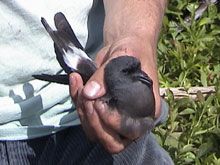 An adult petrel. (Photo: John Anderson / College of the Atlantic)
An adult petrel. (Photo: John Anderson / College of the Atlantic)
 Morris Frank, Dorothy Harrison Eustis, and Buddy I, the founders of The Seeing Eye. (Photo: The Seeing Eye)
Seventy-five years ago this week a blind man named Morris Frank traveled from Tennessee to Switzerland to meet a dog. Not just any dog, but Buddy, a female German Shepherd who had been trained to be his guide. Mr. Frank received his dog from Dorothy Eustis, a canine trainer for police and rescue work. Ms. Eustis had become interested in guide dogs after visiting a school in Germany that had taught them to help blind war veterans. An article she wrote inspired Mr. Frank to imagine greater independence for blind people everywhere. He and Ms. Eustis agreed to pursue this goal together, starting with the training of Buddy.
Morris Frank, Dorothy Harrison Eustis, and Buddy I, the founders of The Seeing Eye. (Photo: The Seeing Eye)
Seventy-five years ago this week a blind man named Morris Frank traveled from Tennessee to Switzerland to meet a dog. Not just any dog, but Buddy, a female German Shepherd who had been trained to be his guide. Mr. Frank received his dog from Dorothy Eustis, a canine trainer for police and rescue work. Ms. Eustis had become interested in guide dogs after visiting a school in Germany that had taught them to help blind war veterans. An article she wrote inspired Mr. Frank to imagine greater independence for blind people everywhere. He and Ms. Eustis agreed to pursue this goal together, starting with the training of Buddy.



 Harris’ Hawk (Photo: Southwest Wildlife)
Harris’ Hawk (Photo: Southwest Wildlife) 




